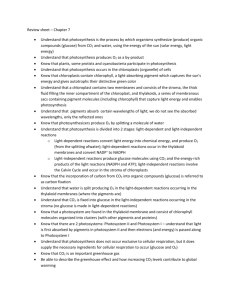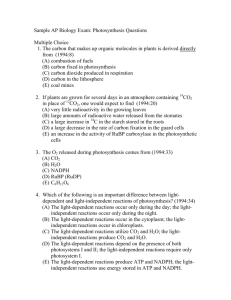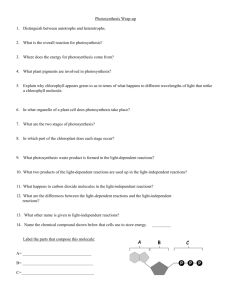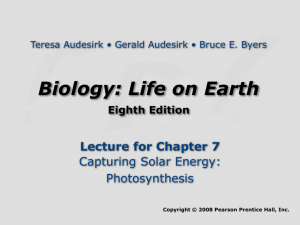Chapter 6 instructor
advertisement
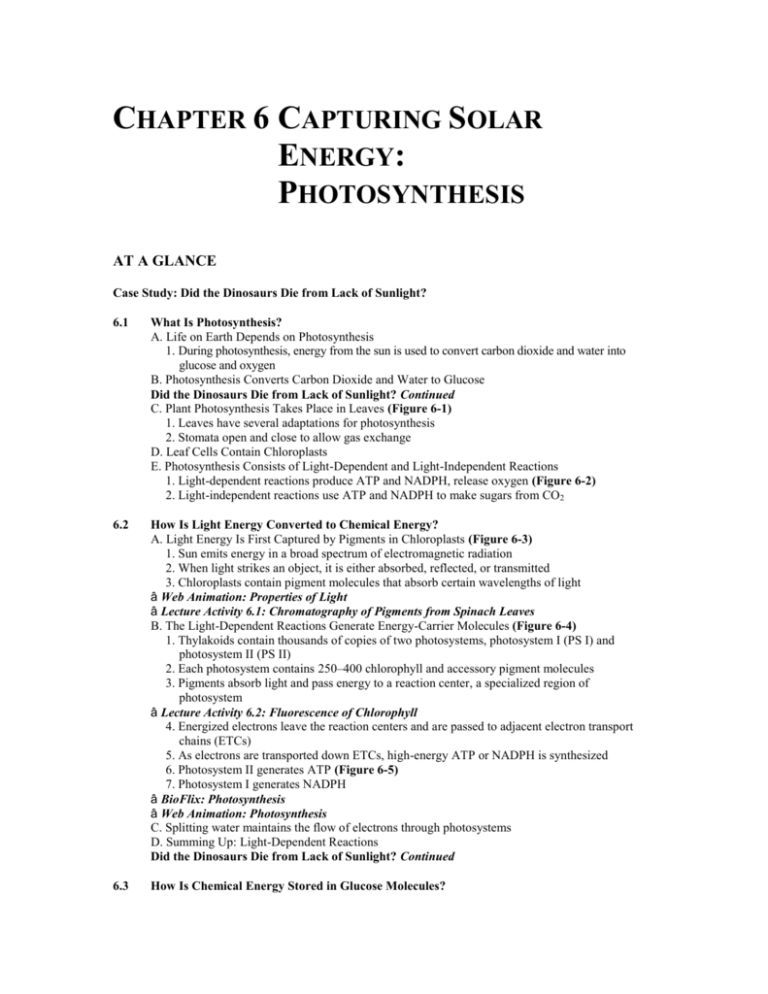
CHAPTER 6 CAPTURING SOLAR ENERGY: PHOTOSYNTHESIS AT A GLANCE Case Study: Did the Dinosaurs Die from Lack of Sunlight? 6.1 What Is Photosynthesis? A. Life on Earth Depends on Photosynthesis 1. During photosynthesis, energy from the sun is used to convert carbon dioxide and water into glucose and oxygen B. Photosynthesis Converts Carbon Dioxide and Water to Glucose Did the Dinosaurs Die from Lack of Sunlight? Continued C. Plant Photosynthesis Takes Place in Leaves (Figure 6-1) 1. Leaves have several adaptations for photosynthesis 2. Stomata open and close to allow gas exchange D. Leaf Cells Contain Chloroplasts E. Photosynthesis Consists of Light-Dependent and Light-Independent Reactions 1. Light-dependent reactions produce ATP and NADPH, release oxygen (Figure 6-2) 2. Light-independent reactions use ATP and NADPH to make sugars from CO 2 6.2 How Is Light Energy Converted to Chemical Energy? A. Light Energy Is First Captured by Pigments in Chloroplasts (Figure 6-3) 1. Sun emits energy in a broad spectrum of electromagnetic radiation 2. When light strikes an object, it is either absorbed, reflected, or transmitted 3. Chloroplasts contain pigment molecules that absorb certain wavelengths of light â Web Animation: Properties of Light â Lecture Activity 6.1: Chromatography of Pigments from Spinach Leaves B. The Light-Dependent Reactions Generate Energy-Carrier Molecules (Figure 6-4) 1. Thylakoids contain thousands of copies of two photosystems, photosystem I (PS I) and photosystem II (PS II) 2. Each photosystem contains 250–400 chlorophyll and accessory pigment molecules 3. Pigments absorb light and pass energy to a reaction center, a specialized region of photosystem â Lecture Activity 6.2: Fluorescence of Chlorophyll 4. Energized electrons leave the reaction centers and are passed to adjacent electron transport chains (ETCs) 5. As electrons are transported down ETCs, high-energy ATP or NADPH is synthesized 6. Photosystem II generates ATP (Figure 6-5) 7. Photosystem I generates NADPH â BioFlix: Photosynthesis â Web Animation: Photosynthesis C. Splitting water maintains the flow of electrons through photosystems D. Summing Up: Light-Dependent Reactions Did the Dinosaurs Die from Lack of Sunlight? Continued 6.3 How Is Chemical Energy Stored in Glucose Molecules? A. The Light-Independent Reactions Manufacture Glucose B. The C3 Cycle Captures Carbon Dioxide (Figure 6-6) â Lecture Activity 6.3: The Role of Carbon Dioxide in Photosynthesis 1. The C3 cycle, or Calvin-Benson cycle, uses the energy in the ATP and NADPH from the lightdependent reactions to make glucose from CO2 C. Carbon Fixed during the C3 Cycle Is Used to Synthesize Glucose â Earth Watch: Are the Benefits of Biofuels Bogus? D. Summing Up: Light-Independent Reactions â Lecture Activity 6.4: Modeling Photosynthesis 6.4 What Is the Relationship between Light-Dependent and Light-Independent Reactions? (Figure 6-7) A. Light-Dependent Reactions Produce High-Energy ATP and NADPH from ADP and NADP + B. Light-Independent Reactions Use Energy from ATP and NADPH to Synthesize Glucose C. Depleted Molecules of ADP and NADP+ Return to Light-Dependent Reactions â Lecture Activity 6.5: Global Warming and Photosynthesis 6.5 How Does the Need to Conserve Water Affect Photosynthesis? (Figure 6-8) A. When Stomata Are Closed to Conserve Water, Wasteful Photorespiration Occurs 1. Photorespiration occurs when O2 rather than CO2 is combined with RuBP 2. This occurs when stomata are closed, CO2 levels drop, and O2 levels rise 3. No useful energy is generated B. Alternative Pathways Reduce Photorespiration C. C4 Plants Capture Carbon and Synthesize Glucose in Different Places (Figure 6-9) 1. Plants that thrive in hot, dry conditions have chloroplasts in both mesophyll cells and in bundle sheath cells 2. In C4 plants, CO2 reacts with a 3-C intermediate, phosphoenolpyruvate (PEP) instead of RuBP to form a 4-C intermediate 3. This reaction is highly specific for CO2, reducing photorespiration 4. The 4-C molecule is shuttled into bundle sheath cells and converted to a 3-C molecule, releasing CO2 5. High CO2 in bundle sheath cells allows the C3 cycle to occur (Figure 6-10) D. CAM Plants Capture Carbon and Synthesizes Glucose at Different Times 1. C4 plants thrive in hot, dry areas where sunlight is plentiful but water is scarce 2. C3 plants are more energy efficient and thrive in cool, wet climates

